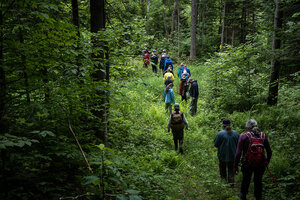Nurturing the vast web of nature
It's taken centuries for humans to begin to understand the true complexities of the nature around us. Now that modern ecologists are treating forests as dynamic ecosystems, healthy restoration can flourish.

Bird-watchers trek through the woods of a 240-acre property managed using ecological forestry, in Unity, New Hampshire, June 8.
Riley Robinson/Staff
For me, one of the joys of walking in the woods has always been the opportunity to feel small. It can be liberating to spend a few hours in the company of a stillness that asks nothing in return.
The weekend after I’d read Richard Mertens’ cover story on forestry, my husband and I went on one of our favorite hikes, in Borderland State Park in southeastern Massachusetts.
As we wound our way through a dense patch of wild blueberry bushes, a flash of tan darted across the path ahead of us. A startled doe dashed through the bushes and settled about a hundred yards away. She eyed us warily before bowing her head to grab a mouthful of berries. She was clearly not too sure about us but wasn’t willing to give up this patch of ripe fruit, either. We enjoyed her presence for a moment before leaving her to browse in peace.
As we hiked, I kept thinking about those blueberries, because they signal a forest in flux. Dick’s reporting helped me realize that. The story is about logging, but it’s also an ode to the woods. Its characters draw timber from the forest but aim to do so in a way that honors the intricate relationships that knit forest communities together. Where foresters of the past focused on sustaining tree populations to ensure future harvests, this new generation of ecological foresters looks to nurture the vast web of plants and wildlife that make up an ecosystem, from leafy canopy to the depths of the forest floor.
A forest, after all, is not a warehouse or even a nursery for trees. It is a dynamic and interconnected community where insects and fungi serve just as vital roles as any maple or oak tree. It’s taken centuries for humans to begin to understand the complexities of these ever-evolving systems. As one ecologist tells Dick, “The key to all of this is humility. We don’t know all the answers. We’re often proven wrong.”
As I walked, I pondered this idea of humility and the willingness to be wrong as a path to understanding.
When we first started hiking here, I was saddened to see stretches of disturbed forest. Remnants of trees, blackened by fire or weakened by disease, jutted erratically up through the brush. I winced at the loss.
But on that summer day, I recognized that the disturbance is in many ways a gift. Wild blueberry bushes thrive in disturbed habitats and are often the first to colonize denuded areas. Before long they can restore a layer of greenery to a clearing, providing cover for countless woodland critters. The roots join a vast network of fungi that redistributes nutrients throughout the forest. In time, saplings will feed off those nutrients as they stretch upward, eventually forming a fresh canopy that shades out this patch of berries entirely.
I marveled at the web of interconnected events happening all around me. This cascade of birth arising from decay will continue to shape this space for years to come. But right then, the deer and I both savored the fruits of the moment.

